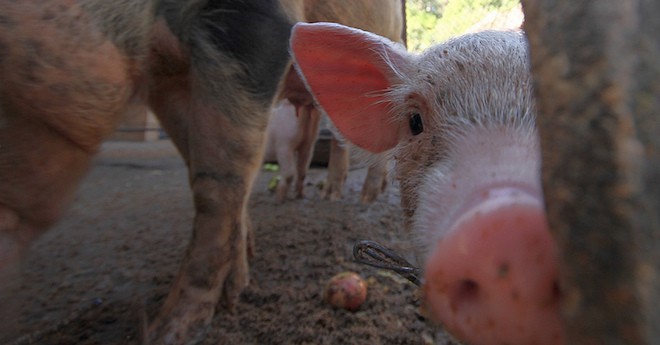
Image: ICStefanescu (CC), Flickr
A troubling and also kind of odd story came out of Denmark this weekend. In a court proceeding, a microbiologist has disclosed that three residents of the country who had no known connection to farming died of MRSA infections caused by ST398, the livestock-associated strain of drug-resistant staph that first appeared among pig farmers in the Netherlands in 2004 and has since moved through Europe, Canada and the United States.
If the report is correct — and sources have told me it is, but I’ve seen no data to confirm it — it reinforces the concern that bacteria which become resistant because of antibiotic use on farms can move off farms and affect the health of people who have no connection to farming.
Livestock MRSA has always one of the best cases for establishing that, because the drug to which it showed the greatest resistance, tetracycline, wasn’t used against human MRSA in the Netherlands, but was used routinely on farms — so the only place the strain could have picked up its unique resistance pattern was in pigs. (Here’s my long archive of posts on pig MRSA, dating back to my book Superbug where the story was told for the first time.)
Just to get them high up, here are some Danish news sources; this sees to have been a widely covered story. Danish isn’t one of my languages, so I’ve relied on Google Translate — not the best practice, but there’s enough agreement among the stories that I am comfortable with it in this case.
- The Information: “Filthy use of antibiotics”
- Kvalls Posten: “Resistant swine bacterium has killed three Danes”
- DR DK: “Politicians are worried about swine bacteria”
- Avisen: “Three Danes die of swine bacteria”
- Ekstra Bladet: “Three died from killer bacteria from pigs”
- Fyens: “University hospital physician: Three died of swine bacteria”
The first way in which this is odd is that this story emerged not from government public health data but during the trial of two journalists, who in 2010 disclosed the names of farms that had been found to be harboring ST398 (alternatively called CC398). The names were published in a long, tough investigative article that accused the government of capitulating to the agricultural industry by gathering data on the presence of MRSA — which was very rare in Denmark — but not publishing it. The journalists, Kjeld Hansen and Nils Mulvad, are being prosecuted for violating the farmers’ privacy. (As a US journalist grateful every day for the First Amendment, the prosecution disturbs me greatly. William Heisel at Reporting on Health has also written about this.)
In trial testimony last week, Prof. Hans Jørn Kolmos of Odense Hospital said that he had one patient who died of a MRSA infection that turned out to be ST398, but who had no farm connection. When he asked the Statens Serum Institute (which performs Denmark’s infectious-disease research and tracking), he said, he learned there had been two more, also with no connection to farming. All three deaths occurred in 2012 and 2013.
It’s important to put those numbers in context. In 2013, according to the Institute, Denmark had 2,103 cases of MRSA; according to one of the news stories, 648 of those were ST398. We don’t even know how many MRSA cases we have in the US because it is not a disease for which doctors have to notify someone — but in 2007, the estimate just of US deaths from MRSA was more than 18,000. We also don’t know how much of our MRSA is ST398, because the US does not track that strain. It’s possible that we have tons. It’s also possible we don’t have much. That’s not because we don’t use agricultural antibiotics, since we do, but because the ecological niche that “pig MRSA” would occupy might have already been filled up by other strains such as community MRSA (which on the other hand barely exists in Europe, leaving living space open for new strains to emerge into).
Finally, what’s also odd about this report is that Denmark, like the rest of Europe, has cracked down on farm-antibiotic use in a way that the US has not. Growth-promoter antibiotics have been banned throughout the European Union since January 2006 — so resistant bacteria coming off farms ought to be less likely. It is possible that Danish farmers are using essentially the same drugs for “disease prevention,” and thus still fostering the emergence of resistant bacteria. If true, that would be a cautionary tale for the US, since the Food and Drug Administration is instituting a growth-promoter ban, but not addressing preventive use. Also, to compensate for the loss of growth promoters, Danish farmers began using zinc and copper as feed additives; and it may be that those turn out to be driving the evolution of antibiotic resistance in similar ways that pharmaceuticals do.
That’s just a glimpse into how complex this situation is, and how many unanswered questions remain from this courtroom claim. But it’s also a reminder that agricultural antibiotic use has complex, potentially dangerous effects that extend far beyond a farm’s fences, and therefore deserves close scrutiny.